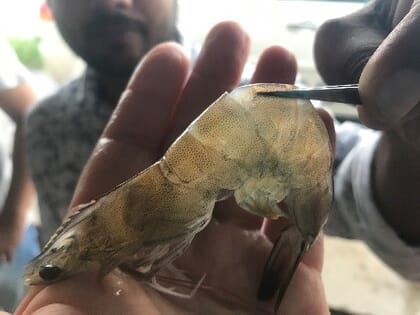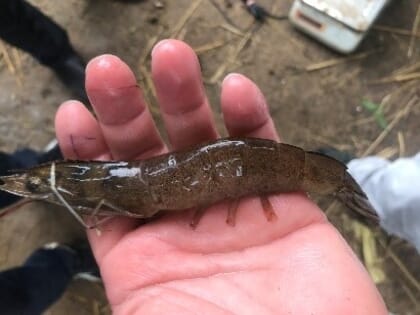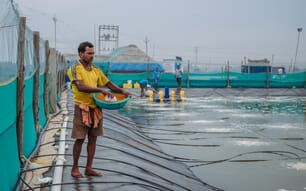Anecdotal evidence suggest that EHP is more prevalent in grow-out ponds of whiteleg shrimp (Litopenaeus vannamei) where the salinity is high - >15 parts per thousand (ppt) - compared to grow-out ponds with low salinities (<5 ppt). Considering that whiteleg shrimp is an euryhaline species, we were interested to find out if EHP infects the species in high (30 ppt), medium (15 ppt) and low (2 ppt) salinities at the same rate.
The most important disease in shrimp farming
Hepatopancreatic microsporidiosis (HPM), which is caused by the microsporidium EHP, is probably the most important disease in shrimp farming at the moment. EHP has been reported in shrimp producing countries in Asia – including China, Indonesia, Malaysia, Vietnam, Thailand and India – as well as in Venezuela. The main clinical signs of EHP are growth retardation, which leads to increased size variability. In advanced stages of the disease, EHP-infected shrimp typically display soft shells, and chronic mortalities. In some cases, the coinfection of EHP and Vibrio spp. has been associated with the development of white faeces syndrome (WFS). Histopathological lesions induced by EHP in the hepatopancreas display irregular/regular basophilic inclusion bodies within the cytoplasm, with or without the presence of spores.

© Dr Luis Aranguren
Shrimp farming in different salinities
EHP has been reported in shrimp ponds with a wide range of salinities (below 5 ppt and up to 55 ppt). In countries where EHP has been found, the incidence seems to be higher in ponds with high salinity than low salinity, but there is no study to support a possible relationship between salinity and the levels of EHP infection. The goal of our study was to compare the infectivity of EHP in three different salinities under experimental conditions using faecal strings as inoculum.
Infecting white leg shrimp at three different salinities
Specific pathogen-free (SPF) Litopenaeus vannamei were used for the experimental challenge with EHP. Shrimp were maintained at three different salinities – 2 ppt, 15 ppt, and 30 ppt. For each experimental challenge, 90-L tanks were filled with artificial seawater that corresponded to the three salinity levels with two replicates for each salinity treatment. The temperature was set at 25°C (±0.6). The entire experiment was repeated two times.
Challenge test
Faecal strings from known EHP-infected shrimp were used as inoculum for both experimental challenges. These were collected daily by siphoning an EHP-infected tanks. A small aliquot was preserved in 95 percent ethanol for determining the EHP load, while the rest were used as inoculum to challenge shrimp maintained at different salinities. One hour post-challenge, shrimp were fed daily with a volume of commercial pelleted feed equating to 2 percent of the tank biomass. This inoculation and feeding regimen was designed to allow the animals to first consume the inocula containing the EHP-infectious faecal strings before consuming pelleted diet. The challenges lasted 25 days.

© Dr Luis Aranguren
Results and implications
In our study, we were able to induce experimental infection using faecal strings as the inoculum. The faecal strings, used as a source of EHP inoculum, were sufficient to elicit an infection in shrimp maintained at the three different salinities. The infectivity of EHP in shrimp reared at 2 ppt, 15 ppt, and 30 ppt salinities was confirmed by PCR and histopathology. Our results show that the prevalence and severity of EHP infection was higher at 30 ppt than at 2 ppt and 15 ppt.
This study demonstrated that faeces could be used as EHP inoculum in experimental challenge and concurrently, infectious faeces could be a source of contamination in hatcheries and grow-out ponds. Taking advantage of the detritivorous behaviour of crustaceans and the presence of undigested feeds, comprising 25-50 percent of the faecal matter, we were able to deliver EHP infectious spores to shrimp and perform experimental challenges. Using faeces collected from confirmed EHP-infected shrimp, our experimental design simulated horizontal transmission of EHP, as observed at a farm level. Histopathology of hepatopancreas tissue dissected from experimentally challenged shrimp reared at three different salinities displayed characteristic lesions of EHP infection that include the presence of plasmodium in the cytoplasm of infected epithelial cells, mature spores within the cytoplasm or released spores in the hepatopancreatic tubule lumen.
Litopenaeus vannamei is an euryhaline species which is raised in a wide range of conditions including high salinities (30 ppt), estuarine environments (10-20 ppt), and low salinities (2 ppt). This study confirms EHP is able to cause an infection at a wide range of salinities, varying as much as 2 ppt to 30 ppt. However, the prevalence of the EHP infection increased at 30 ppt salinity (87.5 percent prevalence), compared to 15 ppt (30.0 percent prevalence) and 2 ppt salinity (33.3 percent prevalence).
The difference in the severity of the EHP infection at the three different salinities was probably due to the differential effect of salinity on spore germination. One of the critical phases in the spore germination is the increase of intra-spore osmotic pressure. The difference in salinities led to a hypotonic environment at 2 ppt and 15 ppt compared to hypertonic environment at 30 ppt. It is possible that the hypertonic solution enhances the germination of the spore by increasing the spore activation process.

© Dr Luis Aranguren
Practical applications
In grow-out ponds in some EHP endemic areas in Asia, the salinity conditions are found to vary widely. For example, in India there are shrimp farming areas with high and low salinities. Interestingly, the prevalence of EHP seems to be lower at lower salinities (below 5 ppt), as observed during a shrimp disease survey in Andhra Pradesh in 2019 (Aranguren and colleagues, unpublished).
Similar conditions were recorded in two major shrimp farming areas in Venezuela – Maracaibo lake, where the salinity is around 4-6 ppt, and in Falcon state where the salinity varies from 36-40 ppt. In Venezuela, shrimp farming is not fully integrated, and the movement of nauplii and post-larvae between Falcon and Maracaibo lake area is a common practice. Despite the movement of potentially EHP-infected post-larvae and / or broodstock between these two areas, so far EHP has been detected in the Falcon area only where the salinities are high. In Maracaibo lake, where the salinities are low, EHP has not been reported yet. It is possible that the absence of EHP in shrimp farms in Maracaibo lake could be due to the difference in water salinity.
Conclusions
This study demonstrated that faecal strings from known EHP-infected shrimp could be used as a reliable source of inoculum to conduct EHP experimental infections via the faecal-oral route. An EHP infection can occur in water with a salinity as low as 2 ppt, although the prevalence and the severity of infection is higher at a salinity of 30 ppt. These findings have implications in disease management in EHP-endemic areas.
In shrimp farming areas where EHP is a major sanitary issue, farmers can minimise the risk of EHP infection by stocking EHP-free post-larva, carrying out a thorough disinfection process of the grow-out pond prior to stocking PL, and by using liners to isolate the PL from the natural pond bottom. Alternatively, shrimp can be cultured in lower salinity (~15ppt) to minimise the severity of EHP infection.



